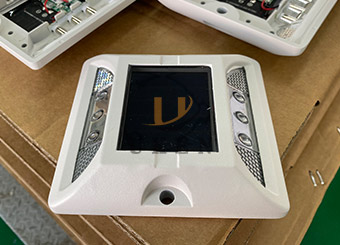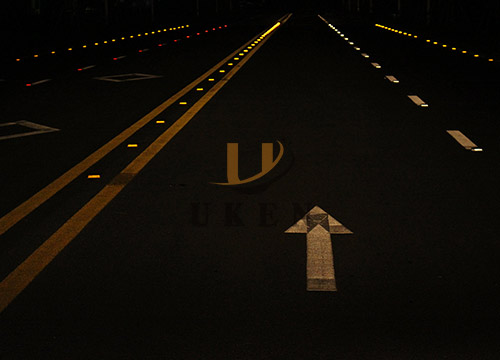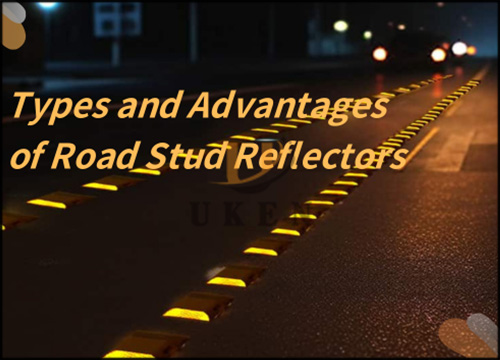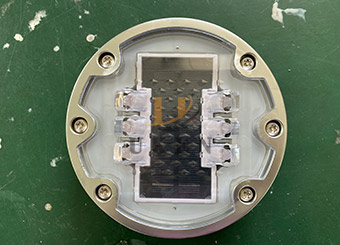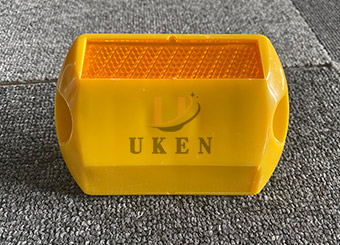Reflective road studs play an indispensable role in the road traffic system. As an important auxiliary facility for road safety, it reflects vehicle lights back to the driver’s line of sight through a unique optical reflection principle, significantly improving road visibility. Especially at night, rain and fog and other adverse weather conditions, reflective road studs can effectively outline the road, reducing traffic accidents caused by poor visibility. Different types of reflective road studs are suitable for different road scenarios due to their different characteristics. The rational selection and application of these studs is the key to improving road safety.
Working principle
The core of glass bead reflective road studs lies in the use of high refractive index glass beads. When the vehicle light irradiation to the surface of the road studs, glass beads as a miniature concentrator, the light will be collected and focused to the back of the reflective layer, and then the light along the original direction of reflection back to the light source. The size and density of the glass beads have a direct impact on the reflective effect: smaller beads focus the light and increase the brightness of the reflection, while a higher density of beads means that more light can be reflected per unit area, enhancing overall visibility.
Product Features
The significant advantage of this type of road stud is its low cost, which makes it suitable for large-scale laying. Their reflective effect is stable and meets the general road safety requirements. However, with the increase of use time, the glass beads are easy to be worn out due to vehicle crushing, sand erosion, etc., resulting in the decline of reflective performance, which needs to be regularly inspected and replaced.
Applicable Scenarios
Glass bead-type reflective road studs are suitable for ordinary roads with moderate traffic flow, such as township roads and community roads. On these roads, their performance is sufficient to ensure the basic road marking needs, while the lower cost also meets the budget constraints.
Maintenance Points
In daily maintenance, the wear and tear of glass beads need to be checked regularly. Comparison of the reflective brightness of the old and new studs can be used to determine whether replacement is required. studs with serious wear and tear should be replaced in time to ensure the effectiveness of the road marking.
Working principle
Reflective film-type road studs using micro-prism structure of high-performance reflective film. Micro-prisms can reflect and refract the incident light many times, even if the light is incident at a large angle, it can be accurately reflected back to the direction of the driver’s vision. This unique structural design provides wide-angle reflective properties and maintains high reflective performance at different angles.
Product Features
Reflective film type road studs have the advantages of high reflective efficiency and wide viewing angle, which are still clearly visible even when viewed from a distance and at a wide angle. It is weather-resistant and can withstand the erosion of UV rays, rain, snow and other harsh environments, and has a long service life. However, relatively speaking, its cost is higher, and it is more suitable for road scenes with higher safety requirements.
Applicable scenes
This type of road stud is widely used in highways, sharp curves, steep slopes, tunnel entrances and exits, and other critical road sections. In these areas, the visibility and reliability of road markings are highly required, and reflective film road studs can provide stable and eye-catching warning signals to effectively protect driving safety.
Technical Advantages
The performance advantages of reflective film road studs are particularly outstanding in wet and dusty environments. Rain on the surface of the studs formed by the water film, will not affect its reflective effect, but to a certain extent can enhance the light gathering; and special surface treatment process, so that it is not easy to adsorb dust, to maintain good reflective properties.
Installation
Embedded reflective road studs need to be installed first in the road surface holes, the depth and diameter of the holes need to be strictly in line with the specifications of the road studs. Usually, the depth of the hole in 5 – 8 cm or so, to ensure that the stud base can be firmly embedded. During installation, the base of the stud is placed into the hole and fixed using high strength glue or concrete, and then the body of the stud is installed after it has cured. The stud body is then installed after it has cured. The entire process is done to ensure that the stud is flush with the road surface and that the tolerances are kept to a minimum.
Product characteristics
Due to their close bond with the road surface, embedded studs have excellent resistance to crushing. Even in the face of frequent crushing by heavy trucks, they remain stable and are not easily displaced or dislodged. With its high stability and long service life, it is a reliable choice for long-term road safety.
Applicable scenes
This type of stud is suitable for the main roads and highways with large traffic flow and heavy vehicles. On these roads, the impact brought about by vehicle travelling is large, embedded road studs can withstand high strength pressure, and continue to play the role of road marking.
Performance Advantages
The design of the embedded studs allows them to blend in with the road surface without affecting the comfort of the vehicle, while reducing the risk of tyre wear caused by stud bulges. The robust installation ensures stable operation in all weather conditions.
Installation method
Surface Mounted studs are extremely easy to install and can be attached directly to the road surface using a special adhesive. Before pasting, make sure the road surface is dry, clean and free of oil and dust. Spread the glue evenly on the back of the stud and press it quickly to make it fit the road surface closely. The whole installation process does not require professional equipment, a single person can operate, greatly saving manpower and time costs.
Product characteristics
The biggest advantage of this type of stud is that it is easy to install, inexpensive and can be deployed quickly. However, their firmness is relatively weak, and they may loosen or fall off under the influence of long-term vehicle crushing and bad weather.
Applicable Scenarios
Surface-applied studs are suitable for short-term or emergency use in temporary roads, construction areas, pavements and other scenarios. For example, during road construction, the studs can be quickly affixed as temporary warning signs; in the vicinity of the event venue, they are used to temporarily delineate the road area to ensure the safety of personnel and vehicles.
Recommendations for use
In order to ensure the service life of adhesive road studs, you should choose special glue with reliable quality and check its firmness regularly after installation. When you find that the road stud is loose, re-paste or replace it in time to avoid road safety due to the dislodgement of the road stud.
Functional characteristics
Guided reflective road studs are mainly used to indicate the direction of the road and the boundary, to provide a continuous and stable reflective signal. Its design focuses on the continuity and consistency of light to help drivers clearly identify lane lines, guide lines and road edges, and guide vehicles to maintain the correct driving track.
Application Scenarios
These studs are commonly used in the lane lines of urban main roads, guide lines of motorways and road edges. On multi-lane roads, guided road studs act as bright ‘road guides’ to ensure orderly vehicle movement and reduce traffic accidents caused by lane confusion.
Design Points
The angle of reflection and brightness of the guided studs need to be accurately designed to provide drivers with clear and easily visible guidance signals under different lighting conditions. At the same time, their colours are usually matched with the road marking colours to enhance visual coherence.
Functional features
Warning Reflector stud warns of potential hazards through dynamic reflection effects such as flashing and colour changing. Unlike the static reflection of ordinary road studs, the dynamic effect can more effectively attract the attention of drivers, reminding them to slow down and drive carefully.
Application Scenarios
This type of road stud is suitable for sharp turns, steep slopes, intersections, construction areas and other dangerous roads. For example, at sharp bends, the red flashing warning-type road studs can inform drivers in advance to pay attention to the risk of turning; in construction areas, the yellow and black colour-changing road studs can clearly warn vehicles to go around.
Technical realisation
The dynamic reflective effect of warning studs can be realised by means of special optical designs or additional devices. Some studs use changes in prismatic structure to produce a flashing effect of light; there are also some studs with built-in micro-reflective lenses, and the colour-changing function is achieved by controlling the angle of the lenses through mechanical or electronic devices.
Functional characteristics
Decorative reflective road studs in the protection of safety warning function at the same time, pay more attention to the landscape beautification effect. Its design incorporates artistic elements, can be customised in different colours and patterns, so that the road is not only safe at night, but also ornamental.
Application Scene
These studs are mostly used in parks, scenic spots, commercial streets and other roads with high requirements for aesthetics. In parks, colourful and decorative road studs can reflect the natural landscape; in commercial districts, personalised studs can enhance the unique atmosphere of the neighbourhood.
Design features
Decorative studs can be designed in a variety of shapes, such as round, square and star, and in a variety of colours, such as red, green and blue, according to the needs of different scenarios. Some studs are also integrated with cultural elements, such as city logos, scenic spots and other characteristic patterns, to enhance regional recognition.
| Compare Projects | Glass bead type | Reflective film type | Embedded | Adhesive | Guided | Warning type | Decorative |
| Reflection efficiency | middle | high | high | middle | middle | high | middle |
| Viewing angle range | narrow | wide | wide | middle | middle | wide | middle |
| Durability | middle | high | high | Low | high | high | middle |
Initial Cost
Glass bead-type studs have the lowest procurement cost and are suitable for projects with limited budget; reflective film-type studs are relatively high in cost due to their high technical content; embedded studs are complicated to install and have a higher initial cost; stick-on studs are easy to install and have a moderate cost; guided and decorative studs have different costs according to their material and design; and warning studs usually have a higher cost due to their special function.
Long-term cost
Glass bead type road studs require regular replacement of worn glass beads, maintenance costs are moderate; reflective film type studs are weather resistant, with a long replacement cycle, long-term maintenance costs are low; embedded road studs have good stability and low maintenance frequency; stick-on type studs are easy to fall off and require frequent inspection and re-sticking, maintenance costs are high; guided and warning studs maintenance costs are related to their material and installation; decorative studs may be more expensive if special design is involved. The maintenance cost of guiding type and warning type studs is related to their material and installation method.
Cost-effective analysis
For ordinary roads, glass bead type or paste type road stud cost-effective; highway and other important road, reflective film type embedded road stud is more cost-effective; temporary or short-term use of the scene, the paste type of road stud economical; and the aesthetic requirements of the region, decorative type of road nails, although the cost is higher, but can bring added value.
Highway: high traffic volume, fast speed, need to choose the reflection efficiency, durability of the reflective film type embedded road stud, to ensure long-term stability of the warning effect.
Temporary construction: short construction period, surface paste type road studs easy to install, low cost, can quickly meet the temporary warning needs.
Landscape road: such as parks and scenic spots, decorative road studs can enhance the aesthetics of the road and visitors’ experience while ensuring safety.
Climatic factors: in rainy, snowy or sandy areas, should choose weather-resistant reflective film-type road studs to prevent bad weather affecting the reflective properties.
Traffic flow: roads with high traffic flow and heavy vehicles need to choose embedded road studs with strong load-bearing capacity to ensure that road studs can still work properly under long-term crushing.
High budget projects: high performance reflective film type embedded road studs can be preferred, the pursuit of the best safety effect and service life.
Limited budget projects: glass bead-type studs or surface-adhesive studs are economical and practical choices to meet the basic safety needs while controlling the cost of expenditure.
Road construction and managers in the choice of reflective road stud, should fully consider the use of the scene, environmental conditions and budgetary factors, scientific selection. From the reflective material, glass bead type economical and practical, reflective film type efficient and durable; according to the installation method, embedded solid and durable, paste type convenient and flexible; according to the function of use, guiding type to guide the direction, warning type to remind the danger, decorative type to beautify the environment. Different types of road studs have their own characteristics and are suitable for different scenarios. Through the rational application of various types of reflective road studs, to improve road safety level, for travellers to create a safer and more comfortable road traffic environment.
